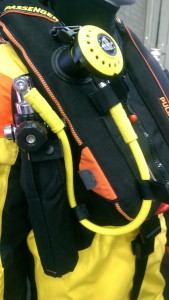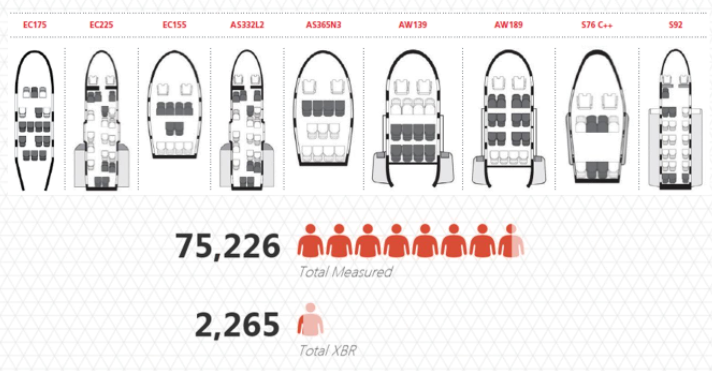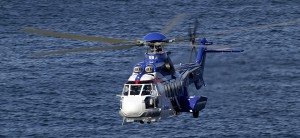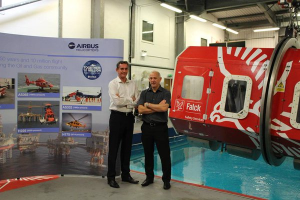Step Change in Safety: Helicopter Safety Update 2016
Step Change in Safety held a webinar on North Sea helicopter safety (covering CA-EBS, emergency egress, FCOMs and airworthiness matters) on 9 March 2016 (following on from a March 2015 event we have previously covered).
Introduction
Step Change is a tripartite UK offshore health and safety organisation combining companies, unions and regulators, formed in 1997. The organisation has 5 strategic themes, each with a steering group:
- Asset integrity
- Competence & human factors
- Workforce engagement
- Simplification (and standardisation)
- Helicopter safety
Les Linklater, Executive Director of SCinS, briefed on the activity of the Helicopter Safety Steering Group (the HSSG). In particular he discussed the introduction of Category A Compressed Air- Emergency Breathing Systems (CA-EBS) and passenger size procedures following the UK Civil Aviation Authority (CAA) CAP1145 report published 20 February 2014.
Category CA-EBS
We have previously discussed at length the rapid development, certification and introduction of the Survitec Mk50 Passenger Lifejacket with a Compressed Air EBS (CA-EBS). The earlier LAPP Jacket with a hybrid rebreather has recently been withdrawn from HUET training with the introduction of a new OPITO Basic Offshore Safety Induction and Emergency Training (BOSIET) and Further Offshore Emergency Training (FOET) standard (which we have previously discussed). The Mk50 lifejacket is now used, however ‘wet’ CA-EBS training has not been introduced as yet.
It was noted that the CA-EBS is a “fundamentally better” system than the previous hybrid rebreather and the goal is to introduce wet training.
The UK regulator, the Health and Safety Executive (HSE), “perceive a risk” of barotrauma for repeated ascents from a depth of 1.5m during HUET. This was called a “minuscule’ risk but one that that “needs to be managed”. It was suggested during Q&A that it was originally understood that the HSE would waive certain requirements of the Diving at Work Regulations during HUET training but that a “risk averse” position is currently being taken. Engagement on the medical requirements are still on-going.
Participants made positive comments about the revised HUET training but there was support for resolving the issues to allow wet training.
In the UK the Survitec Mk50 passenger lifejacket and CA-EBS in use. Two performance reviews have been successfully held with Survitec on the Mk50 jacket.
Survitec Mk51 and Viking jackets with CA-EBS are to be used for flight crew.
CA-EBS implementation is estimated to have cost about £20 million across the UK workforce.
Passenger Size
Passenger size has also proved an implementation challenge, hence the decision to focus on bi-deltoid shoulder measurement as an appropriate single measurement which can be done by trained offshore medics. Implementing this measurement programme was a ~£1 million investment to measure 75,000 people.
Passengers classified as Extra Broad (XBR) have bi-deltoid measurement >22in.

Passenger Size (Credit: Step Change in Safety)
XBR passengers must seat in selected, marked seats with escape routes compatible with their size. Over 75,000 UK offshore personnel have been measured, only 3% are XBR and none the Super XBR category. As 30% of seats in the current fleet are XPR compatible (shaded grey in the diagram below) it is unlikely this restriction will every adversely affect any individual flight.
It has been decided that only those with an initial measurement of over 20in will be re-measured every 4 years (prior to HUET training and ideally, for simplicity and efficiency, by offshore medics).
There had been feedback that the XBR seating is not consistently occurring on return journeys (were Helideck Landing Officers [HLO] are responsible for verifying seating). A quick poll was conducted online and, of those that had a view, 18% believed there are or have been issues with the XBR seating process. SCinS appealed for direct feedback.
Airbus Helicopter Briefing
Andrew Dettl, the Airbus Helicopters Director in Aberdeen gave a detailed and very open presentation on its current safety initiatives.
Airbus Helicopters has 11,858 aircraft currently in service and its helicopters have flown 90 million flight hours worldwide in total, 10 million on oil and gas operations. The company has 32 of its products operating from Aberdeen.
In addition to their traditional attention as a manufacturer on the continued airworthiness of their fleet, there has been a greater focus in recent years on reliability and operational issues in partnership with their customers. One example has been the cooperation on better explaining the automation features on new helicopters which lead to the development of new Flight Crew Operating Manuals (FCOMs) in collaboration with members of HeliOffshore.
Traditional airworthiness attention of course continues and Andrew describes a couple of topical issues:
- Minor Main Gear Box (MGB) casing web cracks have been found on 6 H225s during daily inspections on 6 aircraft around the world since December 2014. Crucially this cracking does not affect the containment of oil. Following extensive Finite Element analysis the cracking is understood and is being addressed by a ‘polishing’ action to eliminate the potential for stress raisers.
- An Alert Service Bulletin (ASB EC225-05A046) was issued 8 March 2016 on H225 cabin push-out windows (along with AS332-05.01.05 on the AS332 Super Puma family). An Airworthiness Directive (AD) from the European Aviation Safety Agency (EASA) is imminent (UPDATE: AD 2016-0049 issued 10 March 2016 and discussed here). The ASB follows a report from a VIP operator, where during the routine scheduled test of a window jettison some difficulty was encountered. Airbus Helicopters did a trial, jettisoning 150 windows, and while they could all be jettisoned there was some variability in the force required. The ASB involves the use of PTFE tape to ensure a lower the push out force. The tape was delivered a few days ago and operators are already scheduling the modification. A 1o0 flying hour compliance period is anticipated for offshore helicopters.
- The replacement of the vertical bevel shaft following two H225 ditchings in 2012 (see: AAIB Report on the Ditchings of EC225 G-REDW 10 May 2012 & G-CHCN 22 Oct 2012) was discussed. The first of the new enhanced shafts were delivered in June 2014 and the entire oil and gas fleet (117 aircraft world wide, were retrofitted by September 2015). The new shaft has now accumulated over 100k flying hours with no problems.
 Although the priority remains avoiding ditchings or water impacts, Airbus Helicopters are progressing several survivability improvements:
Although the priority remains avoiding ditchings or water impacts, Airbus Helicopters are progressing several survivability improvements:
- Airbus Helicopters have recently staged a series of escape trials at the Helicopter Underwater Escape Training (HUET) facility of Falck Safety Services in Aberdeen. This tested new window jettison handles and grab handles to aid egress. Volunteer workers used LAPP jackets to allow up to a 60 second delayed egress. Trained drivers used the Mk50 CA-EBS. Allan Smillie of TAQA discussed the volunteer’s experience during the egress trials. He noted that the trial scenarios were more realistic than normal HUET training as, for example, more people escaped through one window and that the window seal had to be removed first. While the trial was more realistic, in Q&A it was pointed out that normal HUET training does give the basic escape skills (as intended) and is not designed to re-create actual accidents. He gave positive feedback on this type of collaborative, innovative initiative.
- The new, easier to grip, window jettison handles tested during the trial are already available and some will be fitted during the PTFE tape modifications.
- The grab handle modification is still in development because of the associated structural changes necessary for the locations tested during the trial. These are expected to be available for fitment in 2017.
- Enhanced cabin door jettison handles and a belly mounted life raft jettison handle modification are to be certified this year, with introduction into the fleet during 2017.
UPDATE 15 March 2016: AAIB Report on 2013 Sumburgh G-WNSB AS332L2 Helicopter Accident
UPDATE 23 March 2016: EASA published NPA 2016-01 Helicopter ditching and water impact occupant survivability on a 3 month public consultation period.
Previous studies on and accident investigations into helicopter ditchings and water impact events have highlighted inadequacies in the existing certification specifications (CS-27, CS-29) and in the rules governing offshore operations. In particular, it has been established that in an otherwise survivable water impact, most fatalities occurred as a result of drowning because the occupants were unable either to rapidly escape from a capsized and flooded cabin, or to survive in the sea for sufficient time until rescue. Furthermore, the testing environment in which helicopters are type-certified for ditching bears little resemblance to the sea conditions experienced in operation.
In order to thoroughly address these and other ditching-related issues, and due to the nature of ditching-related hazards, this rulemaking task (RMT.0120 (27&29.008)) has taken a holistic approach to the problem, which crosses traditional airworthiness/operational boundaries. A detailed risk assessment has been undertaken that reflects both certification and operational experience and builds upon data extracted from accident reports and previous studies.
The specific objective of this NPA, however, is to propose changes to CS-27 and CS-29… Retroactive rules are to be considered in a second phase of this RMT.
…the primary change proposed aims to establish a new ditching certification methodology by which a target probability of capsize following a ditching can be determined based on the level of capsize mitigation applied to the design.
UPDATE 24 September 2016: The UKCAA has issued CAP1386, their second update on CAP1145. We have summarised that report.
Aerossurance is pleased to sponsor a conference, to be held 6-7 July 2016 at the Royal Aeronautical Society (RAeS) HQ at 4 Hamilton Place, London, on ‘Automation & Offshore Operations’.





Recent Comments